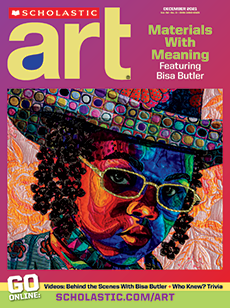Do you feel your pulse quicken as you watch shapes dance across the painting above? The luminous colors in Sarah Cain’s artwork vibrate like caffeine for the eyes. The Los Angeles-based artist doesn’t sketch before painting. “The way I paint is totally intuitive,” Cain says. “I sort of see it right before it’s going to happen, and I have to stay in a state where I’m open to seeing it.”
Cain completed the 2019 painting Mystic Glory on sheet music. An array of geometric shapes layered over playful squiggles in acrylic, gouache, and watercolor pop against the purple background. The composition might make you smile, but that’s not Cain’s goal. “I don’t set out to make happy paintings,” she explains.
Through abstraction, Cain explores processes, like crafting and graffiti, that critics and historians have traditionally seen as beneath fine art. Molly Donovan, a curator at the National Gallery of Art, says the artist “brings the tradition of abstract painting into the present.” Compare Cain’s work with those featured on pages 2-9. What do you notice?
